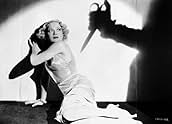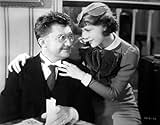Füge eine Handlung in deiner Sprache hinzuA doctor who is also a "mentalist" confesses to a murder. The only problem is that the murder he's confessed to hasn't happened yet--although dead bodies are now starting to turn up all over... Alles lesenA doctor who is also a "mentalist" confesses to a murder. The only problem is that the murder he's confessed to hasn't happened yet--although dead bodies are now starting to turn up all over the place. A reporter sets out to solve the "mystery".A doctor who is also a "mentalist" confesses to a murder. The only problem is that the murder he's confessed to hasn't happened yet--although dead bodies are now starting to turn up all over the place. A reporter sets out to solve the "mystery".
- Regie
- Drehbuch
- Hauptbesetzung
- Auszeichnungen
- 1 wins total
- Detective
- (Nicht genannt)
- Bridge Player
- (Nicht genannt)
- Police Recorder
- (Nicht genannt)
- Announcer
- (Nicht genannt)
- Bridge Player
- (Nicht genannt)
- Hungry Police Guard
- (Nicht genannt)
- Police Desk Sergeant
- (Nicht genannt)
Empfohlene Bewertungen
The 1933 Crime of the Century, directed by William Beaudine, stars Jean Hersholt as Dr. Emil Brandt, a hypnotist who works with people from all walks of life.
Brandt enters the police station begging to be arrested for murder. However, he hasn't committed it yet. His patient, Philip Ames (Samuel S. Hinds) works in a bank. Under hypnosis, he has commanded Ames to bring him $100,000 - and then he plans to murder him.
The Captain, Riley (Robert Elliott) and a detective Martin (David Landau) agree to keep him from killing Ames. Martin will go with him first, and Elliott will replace him when he goes off duty.
When they arrive at the branch home, Brandt's daughter Doris (Frances Dee) arrives home. Martin then is able to leave.
It turns out that Brandt's wife, Doris' stepmother (Wynne Gibson) is somewhat money hungry, and has spent a great deal of Brandt's money. She arrives home to get ready to go to the theater. We find out that she knows about the $100,000 and in fact, she has her boyfriend Gilbert (Gordon Westcott) outside ready to step in and steal the money.
Ames arrives, as does Captain Elliott. Brandt gets the money, replaces it in Ames' pocket with Elliott as witness and programs Ames to return the money.
The lights go out. There's a struggle. Ames is dead and the money is gone. With many suspects. A reporter (Stu Erwin) stops by and tries to put it together.
Later, during a re-enactment, there is another murder.
The film is interrupted toward the end and a man appears, giving the audience one minute to see if they can solve the murder.
One fun thing: a suspect is asked to try on a glove. Shades of OJ.
At 1:11, the film seemed long to me, but it was a good mystery with fine performances and fun re-enactments.
Enjoyable.
An alienist (an old fashioned word for a psychologist or psychiatrist) comes to the police confessing to his part in a crime that has YET to be executed! However, the man (Jean Hersholt) is nice and well respected and the police agree to send someone to his home with him in order to make sure the crime isn't committed. However, the alienist has apparently hypnotized someone into stealing $100,000* from the bank and the 'robber' soon arrives. But before the nice alienist can send the guy back to the bank to return the money, the lights go out and the robber is killed and the alienist is Chloroformed**. Can the police and smarty pants newspaper man solve this bizarre crime?
There is so much that is silly about this one. First, you cannot hypnotize anyone into committing crimes. I have significant training in hypnosis...and if I COULD hypnotize someone into stealing $100,000, I'd sure give it a try! Second, the plot is unnecessarily confusing and complicated. Third, why reveal the wife to be evil so early into the story? This removes much of the suspense and would best have been revealed near the end. Fourth, and most eggregious, is the profuse use of almost every detective story cliche...such as the know-it-all newspaper man who investigates the crime, the evil new wife, as well as hypnosis.
Overall, a crime film with very little to recommend it. There are so many good films in the genre...so why waste your time with this one?
*The $100,000 is in a tiny envelope. This is impossible, as such an amount would be physically much larger...requiring a box or suitcase. $1000 bills are almost unheard of, $100,000 bills are not circulated nor never have been. So, he could have needed, at the least, 1000 $100 bills...and that would not fit inside a tiny envelope.
**How did the smart newspaper guy INSTANTLY know the alienist was Chloroformed?! Many things (such as ether) could knock him out and despite movies and TV shows portraying folks almost INSTANTLY going unconscious when Chloroformed, it takes several minutes to knock someone out this way. And, how did the newspaper man know the other guy was murdered without even inspecting the body?!
The murderer is hard to guess, and this also has some interesting genre features. One is that the main suspect turns himself in before the crime. What mars this is that we have that one anti-cinematic device: the lights go out and events happen without us being able to see them. All crimes happen on-screen, but the crime itself is occluded. This happens twice, each time there is a murder.
As a narrative device, we have evolved away from this one, and I guess I am sad to see it go, because with it, you have purity: everything essential happens in front of you. But evolved away we have, to be replaced by off screen unknowns.
We have also lost the character who is our on-screen detective, but not as a result of cinematic development. These guys just faded from life in general, the newspaper crime reporter. That is a loss too.
It's exactly the sort of picture which could have garnered a real cult following. You could imagine hundreds of fans dressing up as these outrageously cliched characters: bungling cops, a cocky reporter, a femme fetale, a roguish playboy, a mad scientist and his sweet innocent daughter.
Of course, having that fabulous unsophistication of early thirties pictures, after knowing each other for about six hours, the reporter and the daughter fall instantly in love and get married - so nineteen thirties! It's certainly not your typical B picture - it's cheap, tacky, unashamedly over-acted but brilliant, brilliant, brilliant!
Although all the clues are there, you'll never figure out who the murderer is. Even if you rewind back to the bit with the murder during the minute you're invited to guess yourself, you'll chase those red herrings down the wrong path cleverly laid out to trick you. For a B picture, it's got a surprisingly clever story (it is of course based on a play so Paramount can't take all the credit) You also benefit from dynamic direction from pre Will Hay-William Beaudine and even decent, atmospheric photography like a camped-up Old Dark House.
It would never win any awards for filmmaking but if you enjoyed SCOOBY DOO, you'll love this magnificent nonsense.
Which, the cops inform him, isn't a crime until he does it. He goes with one of them to his home, where the patient is waiting..... and the corpses start to pile up.
It's a heck of a set-up, and a pretty good mystery in this definitely pre-code movie, in which reporter Stu Erwin falls in love instantly with Frances Dee, Hersholt's daughter and tries to solve the murder himself. With Torben Meyer, William Janney, Samuel S. Hinds as the patient and Fred Kelsey as a dumb cop.
Wusstest du schon
- WissenswertesToward the end of the film, the story is interrupted by the appearance of an announcer (played by Arthur Hohl) who states that mysteries move too swiftly for the audience to determine the villain, and for this reason a one minute intermission will be provided for them to solve the mystery on their own before returning to the story.
- Zitate
Announcer: [the movie pauses and the announcer makes the following statement after which a clock appears on the screen and the numbers 1 to 60 are superimposed on the faces of the suspects] Ladies and gentlemen, the great trouble with murder stories on the screen is that the audience has no time to solve the mystery. When reading a book, it is possible to put it down at any time to think; in a play, there are intervals between the acts. But a film moves so fast that the audience doesn't have a chance to play detective. Sitting there in your seats, you have witnessed two murders. You have seen exactly how they were done and who were present. All the clues known to the police are known to you. We are trying a little experiment: we are going to give you one minute by that clock, in which to guess who murdered Philip Ames and Mrs Brandt.
Top-Auswahl
Details
- Erscheinungsdatum
- Herkunftsland
- Sprache
- Auch bekannt als
- On Probation
- Drehorte
- Produktionsfirma
- Weitere beteiligte Unternehmen bei IMDbPro anzeigen
- Laufzeit
- 1 Std. 13 Min.(73 min)
- Farbe
- Seitenverhältnis
- 1.37 : 1
































